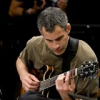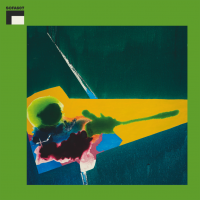Home » Jazz Articles » Extended Analysis » Earl Hines: Earl Hines: Piano Genius At Work
Earl Hines: Earl Hines: Piano Genius At Work
He defied categorization, his considerable chops allowing him to play with just about anybody. Armstrong was the first to recognize his virtuosity. In his first recording session with Hines, he pretends to come across the pianist playing solo. The tune is Hines' own composition "A Monday Date." Pops begs him to let him and the other band members in "on some of that fine music." Hines, pretending to be bored, grudgingly gives his consent, whereupon Armstrong suggests he down half a pint of gin to help him keep up with what's coming.
In reality Hines was no shrinking violet. He very much wanted to be heard and developed a forceful right hand based on Armstrong's playing, to create so-called "trumpet style" piano. Critic Dan Morgenstern, in the booklet accompanying this package, quotes veteran trumpeter Louis Metcalfe, born in 1905, two years after Hines, as saying he couldn't believe his ears the first time he heard "Fatha." "It was the first time I'd heard the piano in a band other than when soloing," said Metcalfe, going on to explain that he was equally surprised by Hines' rhythmic and harmonic abilities when he did solo.
Hines also surprised Maurice Ravel. On a visit to Chicago's Apex Club, the French classical composer heard "Fatha" playing as part of a sextet led by New Orleans clarinetist Jimmy Noone, and his Second Piano Concerto was influenced by the experience.
Hines claimed to have a photographic memory for chords. "The right chords appear in my mind like photographs long before I get to them. This gives me a little time to alter them, to get a little clash or make colouring or get in harmony chords. I get out in deep water and try to get back."
CD1 goes right back to 1928, the year Hines made his breakthrough with Armstrong, but features him playing solo. The opener, "Blues In Thirds" (also known as "Caution Blues"), is a lovely tune, a blues in name only. "Off Time Blues" displays Hines' Armstrong influence and "Chicago High Life" that of another of the founding fathers of jazz, Jelly Roll Morton. The last two tracks, from 1940, are different takes of Hines' "Child Of A Disordered Brain." They're a riot, "Fatha" mixing boogie woogie with virtuoso licks worthy of Art Tatum, of whom more later.
CD2 kicks off with solos, then features Hines reunited with Armstrong, although by now with his All Stars, including Jack Teagarden on trombone and vocals, in a radio broadcast from Chicago's Blue Note nightclub. It seems like a happy romp through such trad chestnuts as "Muskrat Ramble," "Basin Street Blues" and "High Society" but beneath the recorded camaraderie, Hines was bitter concerning his billing and payment for the gig. He takes a backseat to Armstrong and Teagarden, coming to the fore only on his party piece, a boogie woogie treatment of "St. Louis Blues."
There were fewer problems concerning the gig featured on CD3. Hines gets equal billing with trumpeter Muggsy Spanier for this 1954 Chicago session. After an extended, rollicking version of "A Monday Date," the band goes into a decidedly ragged take on Duke Ellington's "Mood Indigo," with an inappropriately showy solo by Hines. "Pops' Blues," featuring veteran New Orleans bassist George "Pops" Foster, is much more coherent and is followed by a fine, laid back "Apex Blues," Jimmy Archey distinguishing himself on trombone. Hines keeps his anarchic inclinations in check on Ellington's "Caravan."
CD4 was recorded with a more "modern" band at San Francisco's Club Hangover, also in 1954, billed as "The Earl Hines Esquire All Stars, featuring Dickie Wells." The ex-Basie trombonist contributes a marvelously enigmatic solo to "Tin Roof Blues." It is echoed (and taken a little too far) by trumpeter Gene Redd. More solid stuff from Wells follows on "Sleepwalking." Hines then sings on "Jump For Joy"—his own tune, not the better known Duke Ellington number.
It's back to trad with another Club Hangover broadcast the following year on CD5 with Darnell Howard (clarinet), Marty Marsala (trumpet) and Jimmy Archey (trombone) but CDs 6 and 7 see Hines playing with a younger, modern quartet starring Calvin Newborn, brother of pianist Phineas, on guitar. Standout tracks: Fatha's tribute to Art Tatum and fine takes on "Thou Swell," "Willow Weep For Me" and "Stomping At The Savoy."
The DVD features grainy black and white footage that includes Hines warbling a few bars of Fats Waller's "Honeysuckle Rose."
It is a great shame that one of the most interesting episodes of Hines' career never made it to posterity. A musicians' union ban stopped him recording with his big band, which launched the careers of singers Billy Eckstine and Sarah Vaughan and—in addition to Bird and Diz—included in its ranks saxophonists Wardell Gray and Budd Johnson.
Track Listing
CD1: Blues In Thirds; Off Time Blues; Chicago High Life; A Monday Date; Stowaway; Chimes In Blues; Panther Rag; Just Too Soon; Caution Blues, A Monday Date; I Ain’t Got Nobody; Fifty Seven Varieties; Glad Rag Doll (two takes); Love Me Tonight (three takes); Down Among The Sheltering Palms (two takes); Rosetta (two takes); Body And Soul; Child Of A Disordered Brain (two takes). CD2: I’ve Got The World On A String; Somewhere Over The Rainbow; Between The Devil And The Deep Blue Sea; Come Rain Or Come Shine; My Shining Hour; As Long As I Live; When It’s Sleepy Time Down South; Muskrat Ramble; A Song Is Born; Basin Street Blues; St. Louis Blues; High Society; Royal Garden Blues; I’ve Got A Right To Sing The Blues. CD3: A Monday Date; Mood Indigo; Wang-Wang Blues; Pops’ Blues; Apex Blues; Caravan; I Ain’t Got Nobody; Mahogany Hall Stomp; Savoy Blues; I’ve Found A New Baby; Relaxin’ At The Touro; Medley: Bugle Call Rag, Ole Miss; I’m Coming Virginia; It’s Right Here For You; When The Saints Go Marching In. CD4: Theme: Dark Forest; Boogie Woogie On St. Louis Blues; Tin Roof Blues; Sleepwalking; Rosetta; Jump For Joy; One O’Clock Jump; Ballin’ The Jack; You’re The Cream In My Coffee; Love Is Just Around The Corner; Hot Soup; The C Jam Blues; Low Down Blues; Jumpin’ With Symphony Sid; Piano Man; Theme: Dark Forest. CD5: Theme: Deep Forest; Ballin’ The Jack; Jazz Me Blues; St. James Infirmary; Honeysuckle Rose; Lady Be Good; Dark Town Strutters Ball; Some Of These Days; Sweet Georgia Brown; Boogie Woogie On St. Louis Blues; On The Sunny Side Of The Street; Back O’Town Blues; Theme: Deep Forest. CD6: Theme: Deep Forest; On The Alamo; Tangerine; Blues For Tatum; Thou Swell; Willow Weep For Me; Stompin’ At The Savoy; Theme: Deep Forest; Do Nothing Till You Hear From Me; Louise; It All Depends On You; Stars Fell On Alabama; Little Girl; Someone To Watch Over Me; Get Happy. CD7: Theme: Deep Forest; Thou Swell; Memphis Blues; Rosetta; Can’t We Talk It Over; Mack The Knife; Tin Roof Blues; Theme: Deep Forest; Give Me The Simple Life; You’re Getting To Be A Habit With Me; Basin Street Blues; Liza; Moonlight In Vermont; Perdido; The Song Is Ended. DVD: I Cover The Waterfront; Medley: Black And Blue, Two Sleepy People; Ain’t Misbehavin’; Squeeze Me; Honeysuckle Rose; Tea For Two.
Personnel
Earl Hines
pianoEarl Hines: piano; Louis Armstrong, Muggsy Spanier, Gene Redd, Don McDonald, Marty Masala: trumpet; Jack Teagarden, Jimmy Archey, Dicky Wells: trombone; Barney Bigard, Darnell Howard, Morris Lane: reeds; Calvin Newborn: guitar; Arvell Shaw, Pops Foster, Ed Garland, Carl Pruitt: bass; Sidney Catlett, Earl Watkins, Eddie Burns, Joe Watkins, Bill English: drums.
Album information
Title: Earl Hines: Piano Genius At Work | Year Released: 2016 | Record Label: Storyville Records
Tags
PREVIOUS / NEXT
Support All About Jazz
 All About Jazz has been a pillar of jazz since 1995, championing it as an art form and, more importantly, supporting the musicians who make it. Our enduring commitment has made "AAJ" one of the most culturally important websites of its kind, read by hundreds of thousands of fans, musicians and industry figures every month.
All About Jazz has been a pillar of jazz since 1995, championing it as an art form and, more importantly, supporting the musicians who make it. Our enduring commitment has made "AAJ" one of the most culturally important websites of its kind, read by hundreds of thousands of fans, musicians and industry figures every month.





















